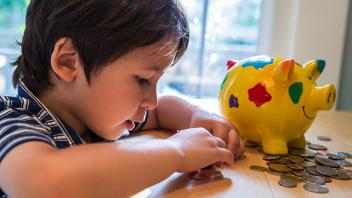Math is all around, even for our youngest learners. By providing a home rich in language and where thinking is encouraged, you can help your preschooler develop important numeracy and literacy skills. Below are four examples of ways to integrate language and math.
Math concept: number
There are many ways to provide your preschooler with counting practice. “Let’s count the number of shoes in our shoe bucket. How many oranges are in the bag?” Another way is to make and reuse a simple set of number cards. Write the numerals 1-10 on one set of cards. Place stickers on the other set. Help your child match the number of stickers with the written numeral. These number cards help develop the understanding that a written number represents something concrete.
Math concept: size
Use socks, balls, pieces of string, or other like objects of varying sizes. Have your child line the objects up across the floor. Next, ask your child to order the objects by size. Use important vocabulary words such as “small, smaller, smallest” or “long, longer, longest.” Help your child to compare items: “This sock is bigger than that one. This string is longer than this one, but shorter than this one.”
Math concept: volume
Fill a plastic bin with dried beans. Add measuring cups, scoops, and paper cups of various sizes. Talk with your child as he works, using interesting words, “Can you sprinkle some beans over here? Let’s scoop the beans into this container.” Use words such as more and less to compare scoops. “Which one holds more? Which one holds less? How many scoops do you think it will take to fill this container with beans?”
Math concept: data analysis
Mathematicians call it data analysis and probability, but you can call it helping your preschooler learn to ask questions and gather information to help answer the questions. Sorting and classifying objects is a great way to begin. Gather several objects of different shapes. Ask your child to sort those objects in different ways. “Can you put all the smooth things over here? Collect all the objects that have an edge.”
Mathematical thinking and problem solving skills are needed every day, and developing a solid foundation will prepare your child to be a lifelong learner.
Download this article in Spanish
Subscribe to Growing Readers!
Get our free monthly parent tips — in English and Spanish — delivered right to your inbox!
